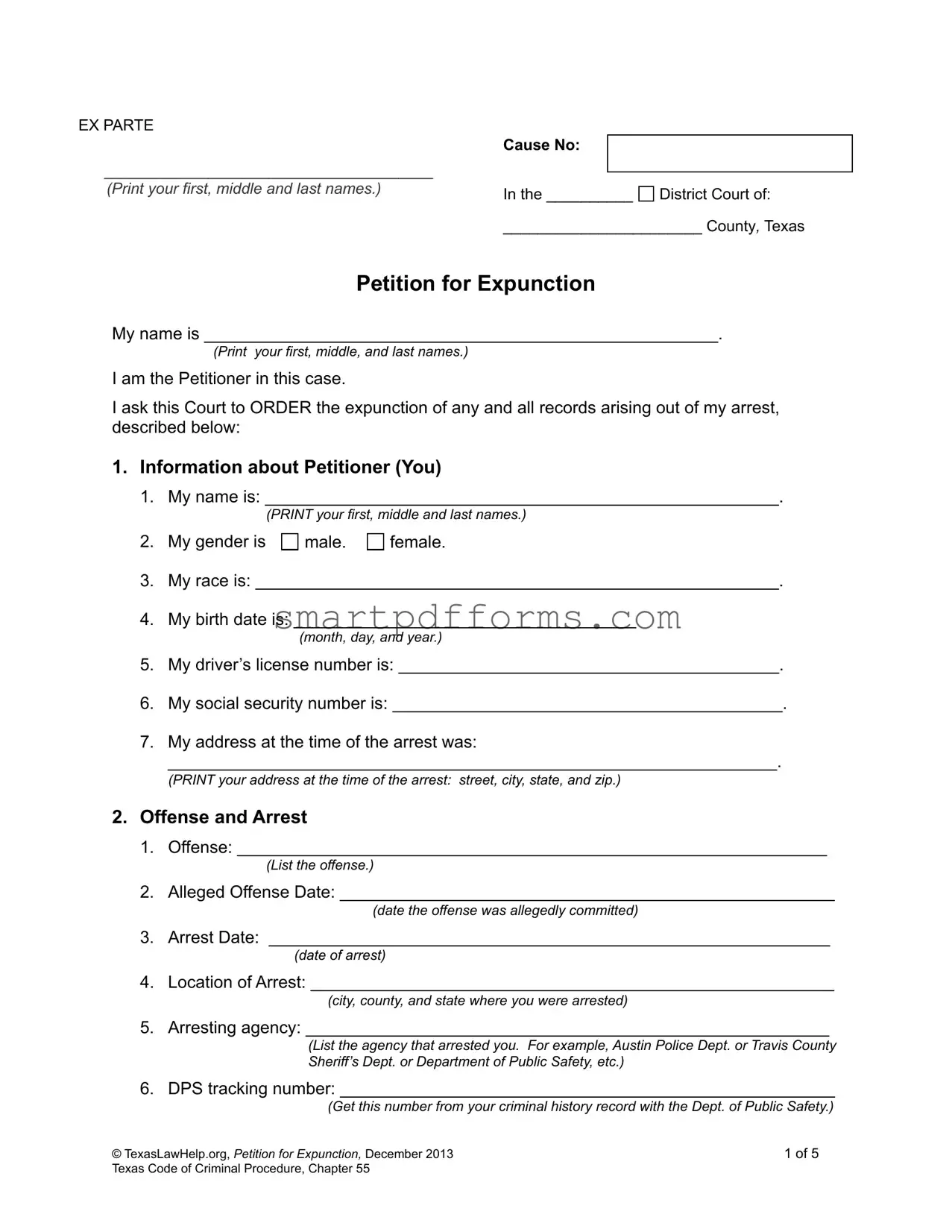EX PARTE
|
Cause No: |
|
|
______________________________________ |
|
|
|
|
|
|
(Print your first, middle and last names.) |
In the __________ |
District Court of: |
|
_______________________ County, Texas
Petition for Expunction
My name is ______________________________________________________.
(Print your first, middle, and last names.)
I am the Petitioner in this case.
I ask this Court to ORDER the expunction of any and all records arising out of my arrest, described below:
1. Information about Petitioner (You)
1. My name is: ______________________________________________________.
(PRINT your first, middle and last names.)
3.My race is: _______________________________________________________.
4.My birth date is: ____________________________________
(month, day, and year.)
5.My driver’s license number is: ________________________________________.
6.My social security number is: _________________________________________.
7.My address at the time of the arrest was:
________________________________________________________________.
(PRINT your address at the time of the arrest: street, city, state, and zip.)
2.Offense and Arrest
1. Offense: ______________________________________________________________
|
(List the offense.) |
|
2. |
Alleged Offense Date: ____________________________________________________ |
|
(date the offense was allegedly committed) |
|
3. |
Arrest Date: ___________________________________________________________ |
|
(date of arrest) |
|
4. |
Location of Arrest: _______________________________________________________ |
|
(city, county, and state where you were arrested) |
|
5. |
Arresting agency: _______________________________________________________ |
|
(List the agency that arrested you. For example, Austin Police Dept. or Travis County |
|
Sheriff’s Dept. or Department of Public Safety, etc.) |
|
6. |
DPS tracking number: ____________________________________________________ |
|
(Get this number from your criminal history record with the Dept. of Public Safety.) |
© TexasLawHelp.org, Petition for Expunction, December 2013 |
1 of 5 |
Texas Code of Criminal Procedure, Chapter 55 |
|
(You my not expunge records
7.(If you have a court cause number or paid a fine you were probably charged with an offense. Talk to an attorney if you’re not sure.)
(Check one.)
I have not been charged with any offense relating to my arrest. (Skip 8.)
I was charged with an offense relating to my arrest. (Go to 8.)
8.(The official charges related to your arrest may have started in one court, and been assigned a cause number, but later transferred to another court, and assigned a different cause number. You need to list the information about all courts and cause numbers that were assigned to your case.)
My charges were originally filed in __________________________ court, and assigned
the following cause number: ____________________________________.
My charges were finally prosecuted in: (Check one.)
the original court, with the same cause number.
the following court: ______________________________________________, with
the following cause number: __________________________________________.
9. My arrest was not pursuant to a probation revocation warrant. of an arrest that occurs pursuant to a probation revocation warrant.)
3. Grounds for Expunction (Check the box of the ground that applies to your case.)
Never Charged (You were never charged with any offense relating to your arrest, and you meet at least one of the following conditions.)
I have not been charged for an offense relating to my arrest and:
(Check all that apply.)

 I was arrested for a Class C misdemeanor and it has been at least 180 days since the arrest. I have not been charged with a felony arising out of the same transaction for which I was arrested. **(See note below.)
I was arrested for a Class C misdemeanor and it has been at least 180 days since the arrest. I have not been charged with a felony arising out of the same transaction for which I was arrested. **(See note below.)

 I was arrested for a Class A or B misdemeanor and it has been at least one year since the arrest. I have not been charged with a felony arising out of the same transaction for which I was arrested. **(See note below.)
I was arrested for a Class A or B misdemeanor and it has been at least one year since the arrest. I have not been charged with a felony arising out of the same transaction for which I was arrested. **(See note below.)

 I was arrested for a felony and It has been at least three years since the arrest. **(See note below.)
I was arrested for a felony and It has been at least three years since the arrest. **(See note below.)

 The prosecuting attorney has certified that my arrest records and files are not needed for use in any criminal investigation or prosecution, including an investigation or prosecution of another person.
The prosecuting attorney has certified that my arrest records and files are not needed for use in any criminal investigation or prosecution, including an investigation or prosecution of another person.

 The Statute of Limitations has run completely for all offenses that could be charged from the arrest. This includes any tolling period that may have occurred. (See Article 12 of the Texas Code of Criminal Procedure for a complete list of the Statute if Limitations for all felonies. The Statute of Limitations for all misdemeanors is two years. The Statute of Limitations begins on the date of the alleged offense. Certain conditions may temporarily stop the Statute of Limitations. Ask an attorney to help you determine if the Statute of Limitations has completely run in your case.)
The Statute of Limitations has run completely for all offenses that could be charged from the arrest. This includes any tolling period that may have occurred. (See Article 12 of the Texas Code of Criminal Procedure for a complete list of the Statute if Limitations for all felonies. The Statute of Limitations for all misdemeanors is two years. The Statute of Limitations begins on the date of the alleged offense. Certain conditions may temporarily stop the Statute of Limitations. Ask an attorney to help you determine if the Statute of Limitations has completely run in your case.)
**(If you ask the Court to expunge your arrest records under this ground before the Statute of Limitations has run, the Court will allow the arresting law enforcement agency and prosecutor to keep your arrest records unless you also file a letter from the prosecutor certifying that your arrest records and files are not needed for use in any criminal investigation or prosecution.)
© TexasLawHelp.org, Petition for Expunction, December 2013 |
2 of 5 |
Texas Code of Criminal Procedure, Chapter 55 |
|

3b. 
 Dismissed (Your charges were dismissed, and you meet the following conditions.)
Dismissed (Your charges were dismissed, and you meet the following conditions.)
My charges were dismissed or quashed on ___________________________________.
(month, day and year that the charges were dismissed.)
I have attached a copy of the order dismissing or quashing the charges to this Petition.
I have been released, and the charge against me has not resulted in a final conviction, and is no longer pending.
I have not submitted to any kind of court ordered supervision for the offense, unless the offense was a Class C misdemeanor.
I did not intentionally or knowingly abscond (jump bail) from the court’s jurisdiction after being released on bail following this arrest.
My charges were dismissed or quashed:
(Check one.)

 because I completed a pretrial intervention program authorized under Section 76.011, Government Code or because I was charged due to mistake, false information, or other similar reason indicating absence of probable cause to believe I committed the offense or because the indictment or information was void.
because I completed a pretrial intervention program authorized under Section 76.011, Government Code or because I was charged due to mistake, false information, or other similar reason indicating absence of probable cause to believe I committed the offense or because the indictment or information was void.

 and prosecution is no longer possible because the Statute of Limitations has run completely for all offenses that could be charged from the arrest. This includes any tolling period that may have occurred. (See Article 12 of the Texas Code of Criminal Procedure for a complete list of the Statute if Limitations for all felonies. The Statute of Limitations for all misdemeanors is two years. The Statute of Limitations begins on the date of the alleged offense. Certain conditions may temporarily stop the Statute of Limitations. Ask an attorney to help you determine if the Statute of Limitations has completely run in your case.)
and prosecution is no longer possible because the Statute of Limitations has run completely for all offenses that could be charged from the arrest. This includes any tolling period that may have occurred. (See Article 12 of the Texas Code of Criminal Procedure for a complete list of the Statute if Limitations for all felonies. The Statute of Limitations for all misdemeanors is two years. The Statute of Limitations begins on the date of the alleged offense. Certain conditions may temporarily stop the Statute of Limitations. Ask an attorney to help you determine if the Statute of Limitations has completely run in your case.)
Acquitted (You were acquitted of your charges.)
(Check one)

 I was acquitted by the trial court. I was not convicted of another offense occurring during this same arrest/alleged criminal episode. No other offense can be charged against me out of this same arrest/ alleged criminal episode. I have attached a copy of the judgment of acquittal to this Petition.
I was acquitted by the trial court. I was not convicted of another offense occurring during this same arrest/alleged criminal episode. No other offense can be charged against me out of this same arrest/ alleged criminal episode. I have attached a copy of the judgment of acquittal to this Petition.

 I was acquitted by the Court of Criminal Appeals or a court of appeals and the period for granting a petition for discretionary review has expired. I was not convicted of another offense occurring during this same arrest/alleged criminal episode. No other offense can be charged against me out of this same arrest/ alleged criminal episode. I realize that it is within this Court’s discretion to expunge my arrest record. I am asking this court to expunge my records. I have attached a copy of the judgment of acquittal to this Petition.
I was acquitted by the Court of Criminal Appeals or a court of appeals and the period for granting a petition for discretionary review has expired. I was not convicted of another offense occurring during this same arrest/alleged criminal episode. No other offense can be charged against me out of this same arrest/ alleged criminal episode. I realize that it is within this Court’s discretion to expunge my arrest record. I am asking this court to expunge my records. I have attached a copy of the judgment of acquittal to this Petition.
3d. Pardoned or Granted Relief Based on Actual Innocence (You were pardoned by the governor or otherwise granted relief by a court based on your actual innocence.)
(Check one.)

 I was convicted, but later pardoned. I have attached a copy of the pardon to this Petition.
I was convicted, but later pardoned. I have attached a copy of the pardon to this Petition.

 I was convicted, but later pardoned or otherwise granted relief based on my actual innocence. I have attached a copy of the pardon or court order to this Petition. The
I was convicted, but later pardoned or otherwise granted relief based on my actual innocence. I have attached a copy of the pardon or court order to this Petition. The
© TexasLawHelp.org, Petition for Expunction, December 2013 |
3 of 5 |
Texas Code of Criminal Procedure, Chapter 55 |
|

pardon or court order clearly shows on its face that it was granted based on my actual innocence.
3e. 
 Prosecutor Recommends Expunction
Prosecutor Recommends Expunction
I have not been tried for the offense for which I was arrested and the prosecutor, authorized to prosecute the offense for which I was arrested, recommends the records of the arrest be expunged.
The prosecuting attorney has recommended that the records of my arrest be expunged.
4. Agencies with Records
I have reason to believe that the following named officials, agencies, and public entities have files or records subject to expunction and should be served with notice of this Petition
(List the NAMES and ADDRESSES of all officials, agencies and public entities that may have files or records of your arrest. You can find examples of agencies that may be included in a Travis County case in the information brochure for expunctions found on www.TexasLawHelp.org .)
(If you aren’t sure which agencies you should list in your petition, consult with an attorney for legal advice. Attach additional sheets if necessary)
© TexasLawHelp.org, Petition for Expunction, December 2013 |
4 of 5 |
Texas Code of Criminal Procedure, Chapter 55 |
|

5. Prayer
I ask the Court to set the case for hearing, and after giving reasonable notice to each official or agency or other entity named in Paragraph 4, order the official, agency or entity to:
1.return all records concerning this arrest to the Court for delivery to me; or if removing the records is not practical, to destroy the records and notify the Court of their destruction, and
2.delete from its public records all index references to the records and files that are subject to the expunction order, and
3.direct any state agency that sent information concerning the arrest to a central federal depository to request the depository to return all records and files subject to the expunction order.
Respectfully submitted,
Petitioner’s signatureDate
_______________________________________________ |
( |
) |
|
Petitioner’s name (print) |
|
|
|
Phone number |
|
|
|
|
|
|
Mailing address: |
street address |
city |
state |
zip |
VERIFICATION
Before me, the undersigned notary, personally appeared the Petitioner named herein, who, having been duly sworn stated:
“I am the Petitioner in this Petition for Expunction. I have read this Petition for Expunction and all fact stated in it are true and correct.”
Do not sign until you are in front of the notary!
Petitioner signs in front of a notary |
Date |
Notary fills out below.
State of Texas, County of
(Print the name of county where this affidavit is notarized.)
Sworn to and subscribed before me, the undersigned authority, on this date:
by _______________________________________________________________________________.
(Print the first and last names of the person who is signing this affidavit.)
(Notary’s seal here)
Notary’s signature
© TexasLawHelp.org, Petition for Expunction, December 2013 |
5 of 5 |
Texas Code of Criminal Procedure, Chapter 55 |
|




 I was arrested for a
I was arrested for a 
 I was arrested for a
I was arrested for a 
 I was arrested for a
I was arrested for a 
 The prosecuting attorney has certified that my arrest records and files are not needed for use in any criminal investigation or prosecution, including an investigation or prosecution of another person.
The prosecuting attorney has certified that my arrest records and files are not needed for use in any criminal investigation or prosecution, including an investigation or prosecution of another person.









 I was acquitted by the trial court. I was not convicted of another offense occurring during this same arrest/alleged criminal episode. No other offense can be charged against me out of this same arrest/ alleged criminal episode. I have attached a copy of the judgment of acquittal to this Petition.
I was acquitted by the trial court. I was not convicted of another offense occurring during this same arrest/alleged criminal episode. No other offense can be charged against me out of this same arrest/ alleged criminal episode. I have attached a copy of the judgment of acquittal to this Petition.
 I was acquitted by the Court of Criminal Appeals or a court of appeals and the period for granting a petition for discretionary review has expired. I was not convicted of another offense occurring during this same arrest/alleged criminal episode. No other offense can be charged against me out of this same arrest/ alleged criminal episode. I realize that it is within this Court’s discretion to expunge my arrest record. I am asking this court to expunge my records. I have attached a copy of the judgment of acquittal to this Petition.
I was acquitted by the Court of Criminal Appeals or a court of appeals and the period for granting a petition for discretionary review has expired. I was not convicted of another offense occurring during this same arrest/alleged criminal episode. No other offense can be charged against me out of this same arrest/ alleged criminal episode. I realize that it is within this Court’s discretion to expunge my arrest record. I am asking this court to expunge my records. I have attached a copy of the judgment of acquittal to this Petition.
 I was convicted, but later pardoned. I have attached a copy of the pardon to this Petition.
I was convicted, but later pardoned. I have attached a copy of the pardon to this Petition.
 I was convicted, but later pardoned or otherwise granted relief based on my actual innocence. I have attached a copy of the pardon or court order to this Petition. The
I was convicted, but later pardoned or otherwise granted relief based on my actual innocence. I have attached a copy of the pardon or court order to this Petition. The

 Prosecutor Recommends Expunction
Prosecutor Recommends Expunction